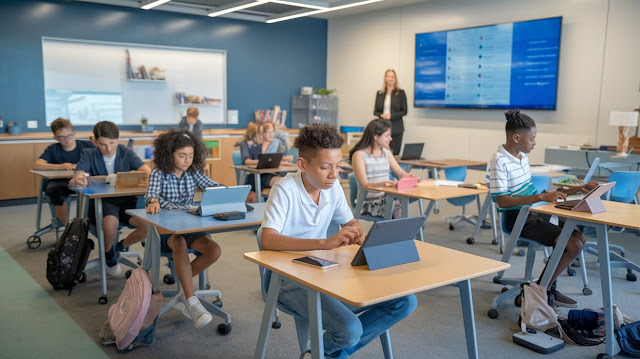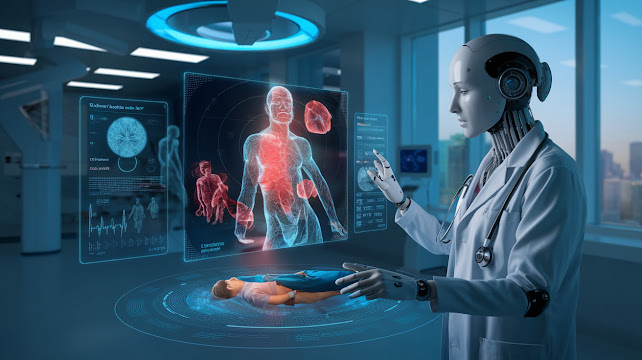AI-Enhanced Learning: How Artificial Intelligence is Changing Education
Artificial Intelligence (AI) is revolutionizing education in ways that were once unimaginable. What was once seen as a traditional, uniform process of schooling is now being personalized, making learning more engaging, flexible, and efficient. In this post, we’ll explore how AI is transforming education through personalized study paths, smart tutoring systems, and interactive content that brings lessons to life. We'll also discuss AI's potential to improve accessibility, streamline administrative tasks, and help educators focus on what they do best—teaching.
The Shift to AI-Enhanced Education
For decades, the education system has remained largely unchanged, relying on a standardized model that doesn't always cater to the unique needs of each learner. With the integration of AI, the landscape of education is shifting dramatically. Schools and institutions are increasingly adopting AI technologies that adapt to individual learning styles, predict educational outcomes, and provide real-time feedback to both students and teachers.
This shift is making education not only more effective but also more inclusive. AI is enabling schools to provide personalized learning experiences for students of all abilities, making quality education accessible to a broader audience.
Personalized Learning Paths
One of AI’s most powerful applications in education is the creation of personalized learning paths. In traditional classrooms, a single teaching method is often used for all students, which can lead to some students feeling disengaged, either because they are not challenged enough or because the material is too difficult. AI helps overcome this issue by adapting the learning experience to fit the needs of each individual student.
- Adaptive Learning Systems
AI-powered adaptive learning systems analyze a student’s progress in real-time and adjust the content accordingly. For instance, if a student is excelling in math but struggling with science, the system will adjust the lessons, giving them more practice where they need it while allowing them to move quickly through areas they have already mastered.
Adaptive learning ensures that students are neither bored nor overwhelmed and helps them learn at a pace that is right for them. Studies have shown that adaptive learning can significantly improve student outcomes by providing the right level of challenge and support based on individual needs.
- Customized Learning Content
AI can recommend content tailored to a student's preferences, strengths, and areas for improvement. For example, an AI system might suggest videos, exercises, or even podcasts that align with a student's learning style—whether they learn best through reading, watching, or doing hands-on activities.
Customized content keeps students more engaged because it taps into their interests and strengths. Moreover, by identifying patterns in how students interact with the material, AI can suggest new topics or methods of learning that might resonate better with them, resulting in a more enjoyable and effective learning experience.
- Progress Tracking and Real-Time Feedback
AI systems continuously monitor a student's progress and provide real-time feedback. Instead of waiting for quarterly or yearly assessments, teachers and students can track performance as they go, allowing for immediate intervention when a student begins to struggle.
This real-time tracking is particularly useful for identifying knowledge gaps and addressing them before they widen. For educators, it means they can be more proactive, offering targeted support to students when it matters most.
Intelligent Tutoring Systems
Intelligent Tutoring Systems (ITS) are perhaps one of the most exciting developments in AI for education. These systems simulate one-on-one tutoring experiences, offering personalized instruction and feedback based on the specific needs of each student. Unlike traditional tutors, however, these systems are available 24/7, making it easier for students to receive help whenever they need it.
- Real-Time Feedback and Assistance
One of the biggest advantages of ITS is the ability to provide instant feedback. Whether a student is working on a math problem or writing an essay, the system can evaluate their work in real-time and offer corrections, explanations, or suggestions for improvement.
This immediate feedback is crucial for learning because it allows students to understand and correct their mistakes right away. Rather than waiting for a teacher to grade an assignment, students can learn from their errors and apply that knowledge to future tasks.
- Interactive and Engaging Learning
ITS are often designed to be interactive, incorporating elements like quizzes, simulations, and virtual tutors. These interactive components make learning more engaging, as students are not simply passive recipients of information—they are active participants in their education.
For example, an AI-powered tutoring system might use a gamified approach, where students earn points or badges for completing lessons and quizzes. This gamification makes the learning process feel more like an adventure, motivating students to stay engaged and continue progressing through the material.
- Scalability of Intelligent Tutoring
Traditional tutoring can be expensive and limited in reach—many students who need extra help may not have access to one-on-one tutoring due to cost or availability. AI tutoring systems solve this problem by providing scalable, personalized tutoring to millions of students simultaneously.
This scalability means that high-quality tutoring is no longer a luxury reserved for a few but can be made accessible to students everywhere, regardless of their economic background or location.
Interactive Content and Immersive Learning
AI is not only enhancing how students learn but also how they experience learning itself. Traditional textbooks and lectures are giving way to interactive content that immerses students in the material. Through AI-driven tools like Virtual Reality (VR), Augmented Reality (AR), and AI-generated content, students can explore new dimensions of learning.
- AI-Generated Content
AI has the ability to create content that adapts to a student’s learning journey. For instance, after a student completes a set of lessons, the AI can generate custom quizzes, exercises, or even full-length assignments that align with the specific areas they need to practice. This targeted practice ensures that students are reinforcing the knowledge they've gained and preparing for future challenges.
In more advanced cases, AI can create entire personalized textbooks or study guides based on the student’s progress and preferences. This allows students to focus on material that is directly relevant to their learning goals.
- Virtual Reality (VR) and Augmented Reality (AR)
Virtual and Augmented Reality are taking education to a whole new level by creating immersive learning environments. Imagine a history class where students can "visit" ancient Rome or an anatomy lesson where they can explore the human body in 3D.
AI powers these experiences by generating realistic simulations that allow students to interact with the material in new and exciting ways. This kind of interactive learning has been shown to improve retention and understanding, as students are not just passively absorbing information—they are actively engaging with it.
- Gamification and Motivation
Gamification is another way AI is transforming education. By incorporating game-like elements into the learning process, AI can make education more fun and motivating.
Students might earn points, unlock badges, or progress through levels as they complete assignments and quizzes. These rewards can be tied to real-world incentives, like extra credit or recognition, encouraging students to stay focused and engaged in their studies. Gamification has been particularly effective in making difficult subjects, like math and science, more accessible and enjoyable for students who might otherwise struggle.
Enhancing Accessibility in Education
AI’s ability to personalize education makes it a powerful tool for improving accessibility. For students with disabilities or those who face other challenges, AI can provide a learning experience that meets their needs in ways that traditional education cannot.
- Learning for Students with Disabilities
AI tools can be customized to accommodate students with various disabilities. For instance, text-to-speech programs can help students with visual impairments, while AI-powered transcription services can assist those who are deaf or hard of hearing.
Additionally, adaptive learning systems can provide alternative ways to complete assignments, such as offering video instructions for students who may struggle with reading or allowing voice-activated commands for students with mobility issues.
- Bridging Educational Gaps
AI also has the potential to bridge educational gaps between students in different regions or of varying socioeconomic backgrounds. By making personalized education scalable and affordable, AI can offer quality learning experiences to students who might otherwise have limited access to resources.
In areas where there may be a shortage of teachers or educational materials, AI systems can step in to provide students with the knowledge and guidance they need to succeed.
Streamlining Administrative Tasks for Educators
While AI is transforming the student experience, it’s also helping educators become more efficient by automating administrative tasks. From grading assignments to organizing lesson plans, AI can free up valuable time for teachers, allowing them to focus on delivering engaging lessons and supporting their students.
- Automated Grading and Assessment
Grading can be one of the most time-consuming aspects of teaching, but AI-powered systems can now automate much of this process. AI can instantly grade multiple-choice tests and even assess more complex assignments, like essays, based on pre-set criteria.
This automation allows teachers to focus on providing more personalized feedback to students, while still ensuring that assessments are fair and consistent.
- Curriculum Development and Planning
AI can also assist with curriculum development by analyzing educational data to determine what strategies are most effective. For example, AI can identify patterns in student performance and suggest adjustments to the curriculum that might improve outcomes.
AI-powered tools can even create lesson plans that are tailored to the needs of specific classes or individuals, saving teachers hours of preparation time.
Conclusion
Artificial Intelligence is changing the way we learn and teach, making education more personalized, engaging, and accessible than ever before. From adaptive learning systems and intelligent tutoring to interactive content and immersive experiences, AI is transforming education for the better.
As AI continues to evolve, its role in education will only grow, offering new opportunities to enhance learning outcomes and make quality education available to students around the world.
Want to learn more about AI in education? Share your thoughts in the comments and subscribe to our blog for more insights on the latest technology trends!
.jpeg)



.jpeg)
.jpeg)
.jpeg)


Comments
Post a Comment